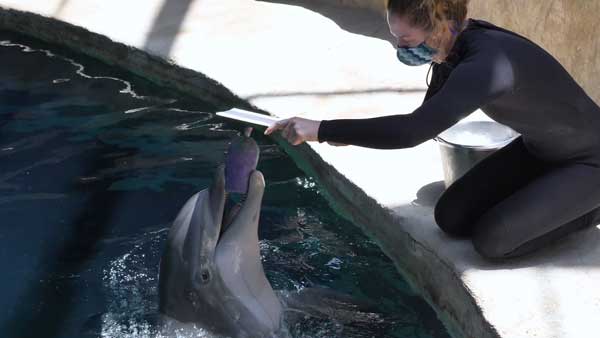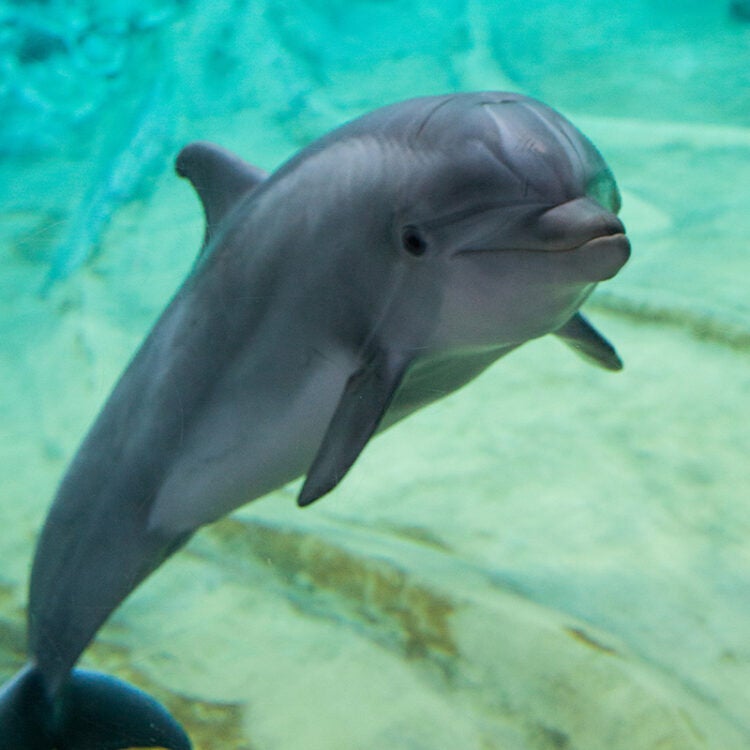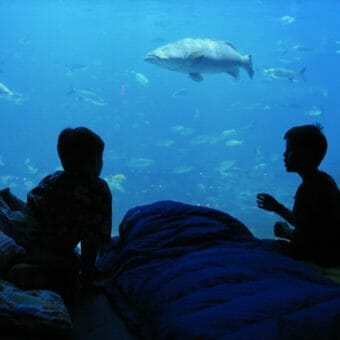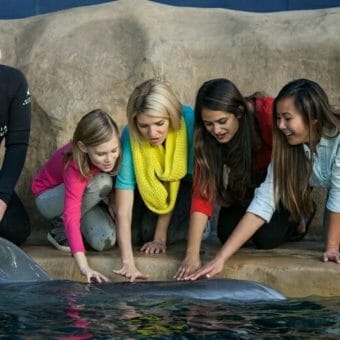-
Size
7-9 feet (2-2.7 m) -
Diet
Fish, cephalopods, crustaceans, small rays or sharks -
Range
Tropical and temperate waters around the world -
Habitat
Bays, tidal creeks, inlets, marshes, rivers and along open ocean beaches
Physical Characteristics
Color
- Generally, slate gray to charcoal in color, including countershading (darker dorsally and lighter ventrally).
- The sides of the body often have light brush markings.
Size
- Average weight and length of an adult ranges between 485 – 595 lbs. (220 – 270 kg) and 7-9 feet (2-2.7 m).
- Length and weight vary widely according to geographic region.
- Body size also typically varies inversely with the water temperature of its location (i.e., larger animals occur in colder regions).
- Average weight and length of a calf is 22-44 lbs. (9.9-20 kg); 2.7-4.6 feet (0.8-1.4 m).
- The maximum adult weight reported in the ocean:
- 626 lbs. (284 kg) from the western North Atlantic
- 1400 lbs. (635 kg) from the eastern North Atlantic.
Teeth
- The common bottlenose dolphin has 72 to 104 teeth.
- Teeth are not replaced if lost.
Skin
- Highly specialized and contains tiny ridges that play an important role in reducing drag.
- The outer layer of skin is shed approximately every two hours to increase swimming efficiency by maintaining a smooth body surface.
- The skin is also an important sensory organ.
- The epidermis (outer layer of skin) is approximately 15-20 times thicker than that of a human.
Animal Fun Fact
Bottlenose dolphins don’t chew food—they usually swallow it whole.
Diet / Feeding
Diet
- The diet of a coastal bottlenose dolphin is diverse and depends on location.
- Many eat only fish, although some consume small numbers of cephalopods, crustaceans, small rays and sharks.
- Dolphins do not chew. Larger prey may be torn into smaller pieces, but most food is swallowed whole.
- It is estimated that in the wild, an adult consumes about five percent of their body weight daily.
Feeding Behaviors
- Feeding behavior ranges from hunting individually to occasional cooperative foraging on schooling fishes.
- Feeding takes place both during the day and at night.
- There is strong evidence that bottlenose dolphins are selective feeders, taking fish disproportionately based on their availability in the environment and especially selecting soniferous (sound-producing) fish.
- Calves learn hunting methods primarily by observing their mothers.
Range / Habitat
Range
- Found in tropical and temperate waters around the world.
Habitat
- Commonly seen in bays, tidal creeks, inlets, marshes, rivers and along open ocean beaches, most often in water depths of about 10 feet (3 m) or less.
Reproduction & Growth
- Male bottlenose dolphins reach sexual maturity between 8 and 13 years of age.
- Female bottlenose dolphins reach sexual maturity between 5 and 10 years of age.
- Gestation lasts about 12 months and the female may bear young into her 40s.
- Births may occur in all seasons, but typically peaks occur during spring, early summer and fall.
- Calves nurse for 18 to 24 months, but may start capturing prey by about one year of age under the tutelage of the mother.
Conservation Status
- Listed as “Least Concern” on the IUCN Red List.
Additional Information
Social units
- Coastal common bottlenose dolphins are primarily found in groups of 2 to 15 individuals. These associations are fluid, often repeated but not constant. Solitary coastal animals can be observed in various regions of the world.
- Group composition has been observed to be dependent on sex, age, reproductive condition, familial relationships and affiliation history.
- Typical social units include nursery groups (females and their most recent calves), mixed-sex groups of juveniles and strongly-bonded pairs of adult males.
Vision
- Vision is similar above and below the water surface.
- Its eyes are adapted for low-light conditions.
- Oily mucus is secreted that lubricates the eye, washes away debris and possibly streamlines the eye as the dolphin swims.
- Scientists are unsure whether this dolphin possesses color vision.
Sleep state
- The bottlenose dolphin engages in unihemispheric slow wave sleep (USWS) in which one half of its brain is in a sleep state, while the other half maintains visual and auditory awareness of the environment while allowing it to surface to breathe.
Lifespan
- In the wild, the average life expectancy is estimated to be between 8.3 and 17.4 years of age.
- In human care in AMMPA facilities, on average 29.2 years of age.
- The oldest dolphin in human care was born on February 27, 1953 and resided for 61 years at Marineland Dolphin Adventure in Marineland, Florida.
- As of 2010, the oldest dolphin in the wild was 60 years, documented in the Sarasota Bay population.
Swim speed
- Adults routinely swim at speeds of about 3-7 mph (5 – 11 km/h).
- The maximum observed swim speed of a common bottlenose dolphin was about 18 mph (29 km/hr) for a very short distance.
Dives/Depths
- The average dive duration for the coastal bottlenose dolphin ranges from 20-40 seconds. The maximum voluntary breath-hold recorded was 7 minutes 15 seconds.
- Coastal dolphins inhabit waters about 10 feet (3 m) deep and so rarely go deeper.
- A trained coastal bottlenose dolphin reached depths of 1,280 feet (390 m).
- A tagged offshore dolphin reached depths of 1,614 feet (492 m).
Hearing
- This dolphin species has a range of hearing much wider than ours.
- The sound of human speech falls well within this range, so dolphins can hear what we say.
Smell
- A dolphin’s brain lacks an olfactory system (sense of smell).
Vocalization
- Wide range of vocalizations, including whistles, grunts, trills, squeaks and moans.
- Dolphins communicate in order to hunt efficiently, raise young and guard against predators.
- It has been determined that individuals develop a specific “signature whistle” within the first few months of life and that this signature whistle remains the same throughout its life. Individuals use their unique whistles to communicate identity, location and, potentially, emotional state.
Echolocation
- Click-like pulses produced by nasal sacs in its trachea are used for echolocation, which is its primary sensory system. The bounce-back from these signals is received in the lower jaw bone and transmitted to the inner ear, which sends nerve impulses to the brain.
- Echolocation allows the animal to locate prey, identify predators and navigate in the dark or in murky water.
- Using echolocation, a dolphin can determine size, shape, structure, composition, speed, distance, and direction.
- Its range is about 230 feet (70 m). Field studies have shown that the common bottlenose dolphin uses its echolocation only as necessary. Field studies have shown that individuals do not continuously produce clicks.
Threats
- Mortalities and serious injuries from entanglement in recreational and commercial fishing gear are currently among the most serious threats to bottlenose dolphins.
- The accumulation of chemicals and heavy metals released into the environment by human activities continues to impact dolphin populations both directly and indirectly.
- Feeding or swimming with dolphins in the wild teaches them to approach boats, making them vulnerable to potential propeller strikes, gear entanglement, ingestion of foreign objects, or intentional harm from humans.
Sources
- AMMPA Standardized Information: Bottlenose Dolphin. Association of Marine Mammal Parks and Aquariums (2/21/2011) 25 pp.
- John Elliott Reynolds, Randall S. Wells, and Samantha D. Eide. The Bottlenose Dolphin: Biology and Conservation. Gainesville: University of Florida, 2000.
- Kelly Jaakkola and Kevin Willis. How long do dolphins live? Survival rates and life expectancies for bottlenose dolphins in zoological facilities wild populations. Marine Mammal Science. 2019.
Unique Gifts from Georgia Aquarium
Bring the memories home with you! Stop by our gift shop for all your dolphin gifts or shop online here.
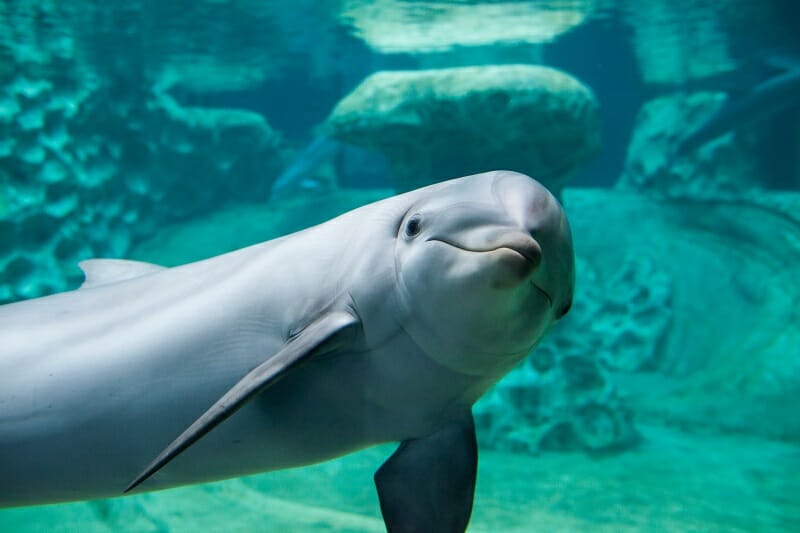
Dolphin Paintings Now Available!
Artists come in all different shapes, sizes and species! For the first time, you can purchase a unique piece of art that serves as an incredible conversation piece, or an unforgettable gift. Pieces are created by our animals getting in touch with their inner artist during one of their favorite types of enrichment – painting! Learn more here.
